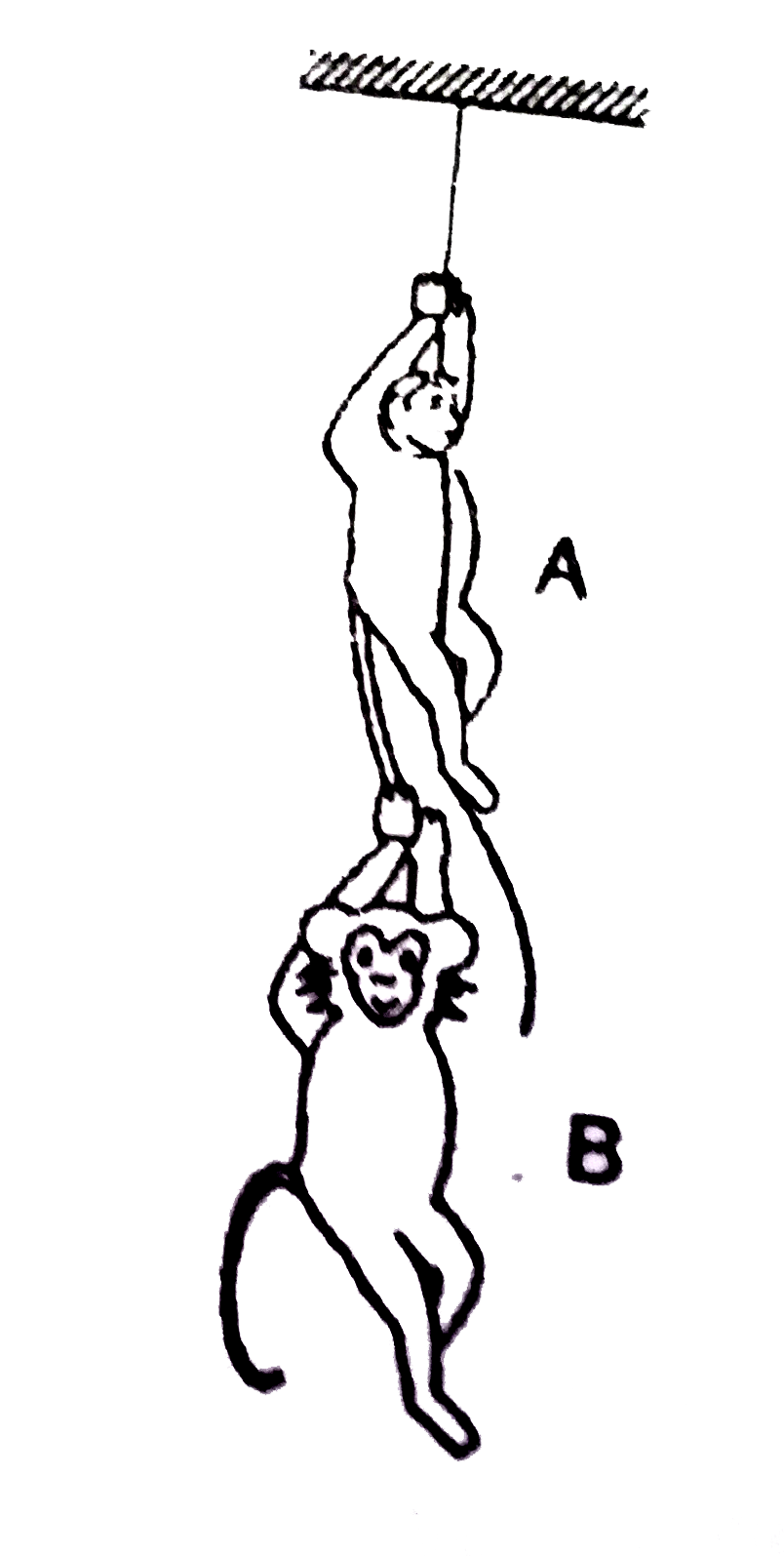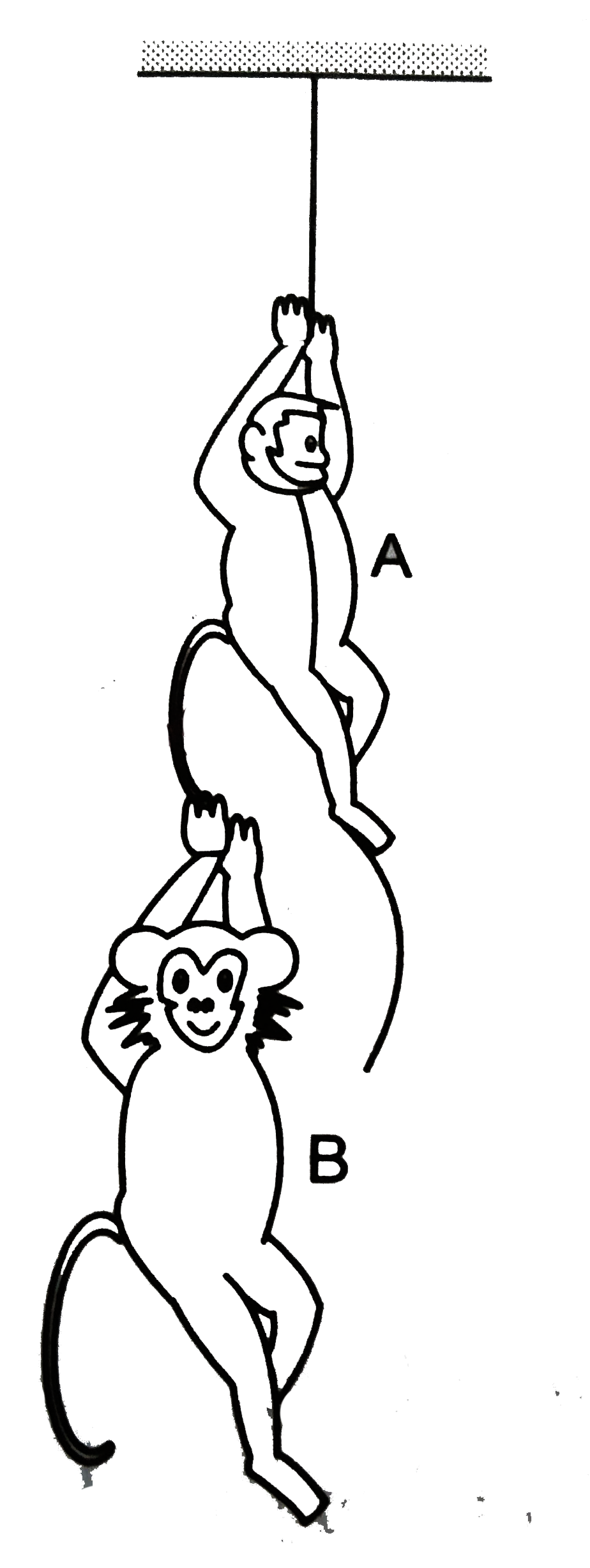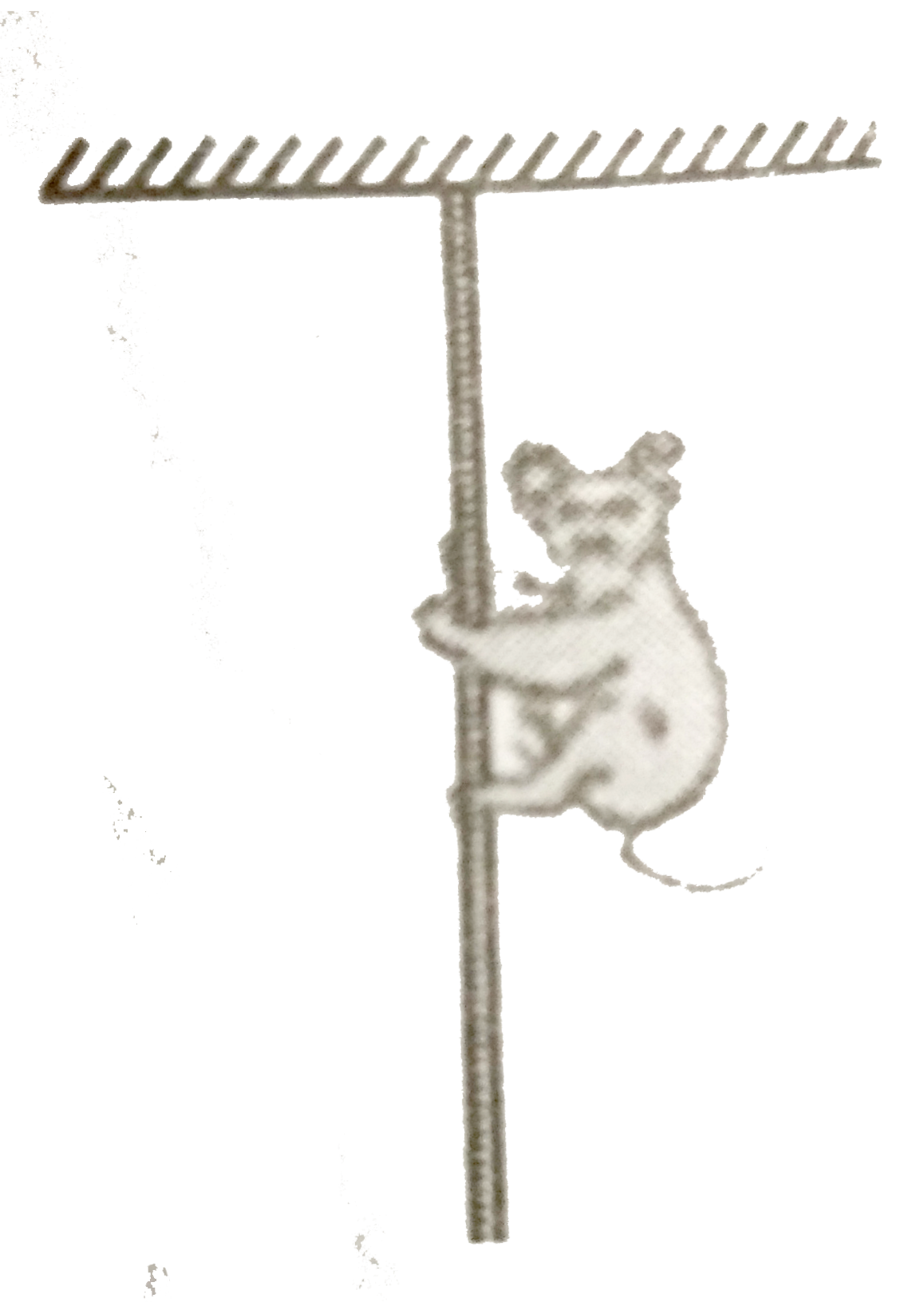A monkey A (mass = 5kg) is climbing up a rope tied to a rigid support. The monkey B (mass = 2kg) is holding on to the tail of monkey A. If the tail can tolerate a maximum tension of 30N, what force should monkey A apply on the rope in order to carry monkey B with it? (g=10m/s2).
The correct Answer is:between 70N and 105N
To solve the problem step by step, we will analyze the forces acting on both monkeys and use Newton's second law of motion.
Step 1: Identify the Forces Acting on Monkey A
Monkey A has a mass of 5 kg. The forces acting on Monkey A are:
- The tension T in the rope acting upwards.
- The weight of Monkey A acting downwards, which is given by WA=mA⋅g=5kg⋅10m/s2=50N.
Step 2: Write the Equation of Motion for Monkey A
Since Monkey A is climbing up with an acceleration a, we can write the equation of motion as:
T−WA=mA⋅a
Substituting the values:
T−50=5a(1)
Step 3: Identify the Forces Acting on Monkey B
Monkey B has a mass of 2 kg. The forces acting on Monkey B are:
- The tension T in the tail acting upwards.
- The weight of Monkey B acting downwards, which is given by WB=mB⋅g=2kg⋅10m/s2=20N.
Step 4: Write the Equation of Motion for Monkey B
The maximum tension that the tail can tolerate is 30 N. Therefore, we write the equation of motion for Monkey B as:
T−WB=mB⋅a
Substituting the values:
T−20=2a(2)
Step 5: Solve the Equations Simultaneously
From equation (1):
T=50+5a(3)
From equation (2):
T=20+2a+30(4)
Substituting T from equation (3) into equation (4):
50+5a=20+2a+30
Simplifying:
50+5a=50+2a
5a−2a=50−50
3a=0⟹a=0(not possible, we need to find a positive acceleration)
Step 6: Find the Maximum Tension
Since the maximum tension T that the tail can tolerate is 30 N, we can set T=30 in equation (2):
30−20=2a
10=2a⟹a=5m/s2
Step 7: Substitute Back to Find the Force Applied by Monkey A
Now substituting a=5m/s2 back into equation (3):
T=50+5(5)=50+25=75N
Conclusion
The force that Monkey A should apply on the rope to carry Monkey B with it is 75 N.
---
Monkey A has a mass of 5 kg. The forces acting on Monkey A are:
- The tension T in the rope acting upwards.
- The weight of Monkey A acting downwards, which is given by WA=mA⋅g=5kg⋅10m/s2=50N.
Since Monkey A is climbing up with an acceleration a, we can write the equation of motion as:
T−WA=mA⋅a
Substituting the values:
T−50=5a(1)
Monkey B has a mass of 2 kg. The forces acting on Monkey B are:
- The tension T in the tail acting upwards.
- The weight of Monkey B acting downwards, which is given by WB=mB⋅g=2kg⋅10m/s2=20N.
The maximum tension that the tail can tolerate is 30 N. Therefore, we write the equation of motion for Monkey B as:
T−WB=mB⋅a
Substituting the values:
T−20=2a(2)
From equation (1):
T=50+5a(3)
From equation (2):
T=20+2a+30(4)
Substituting T from equation (3) into equation (4):
50+5a=20+2a+30
Simplifying:
50+5a=50+2a
5a−2a=50−50
3a=0⟹a=0(not possible, we need to find a positive acceleration)
Since the maximum tension T that the tail can tolerate is 30 N, we can set T=30 in equation (2):
30−20=2a
10=2a⟹a=5m/s2
Now substituting a=5m/s2 back into equation (3):
T=50+5(5)=50+25=75N
The force that Monkey A should apply on the rope to carry Monkey B with it is 75 N.
Topper's Solved these Questions
- LAWS OF MOTIONBook:AAKASH SERIESChapter:LAWS OF MOTIONExercise:QUESTIONS FOR DESCRIPTIVE ANSWER
Explore 5 Videos
- LAWS OF MOTIONBook:AAKASH SERIESChapter:LAWS OF MOTIONExercise:Problem
Explore 162 Videos
- LAWS OF MOTIONBook:AAKASH SERIESChapter:LAWS OF MOTIONExercise:NUMERICAL EXERCISE ( LEVEL-1)
Explore 16 Videos
- GEOMETRICAL OPTICSBook:AAKASH SERIESChapter:GEOMETRICAL OPTICSExercise:ADDITIONAL PRACTICE EXERCISE (LEVEL-II PRACTICE SHEET (ADVANCED) INTEGER TYPE QUESTIONS)
Explore 10 Videos
- LOGIC GATESBook:AAKASH SERIESChapter:LOGIC GATESExercise:Exercise (Very Short Answer)
Explore 10 Videos
Similar Questions
The monkey B shown in fig. is holding on to the tall of the monkey A which is climbing up a rope. The masses of the monkeys A and B are 5 kg and 2kg respectively. If A can tolerate a tension of 30N in its tall, what force should it apply on the rope in order to carry the monkey B with it ?
(Take g=10ms−2)

View SolutionThe monkey B shown in figure is holding on to the tail of the monkey A which is climbing up a rope. The masses of the monkeys A and B are 5 kg and 2kg respectively. If A can tolerate a tension of 30 N in its tail what force should it apply on the rope in order to carry the monkey B with it? Take g=10 ,m/s2.

View Solution
Knowledge Check
A monkey of mass 40 kg climbs on a massless rope which can stand a maximum tension of 500 N. In which of the following cases will the rope break? (Take g=10ms−2)
 AThe monkey climbs up with an acceleration of 5ms−2.BThe monkey climbs down with an acceleration of 5ms−2.CThe monkey climbs up with a uniform speed 5ms−2.DThe monkey falls down, the rope freely under gravity.
AThe monkey climbs up with an acceleration of 5ms−2.BThe monkey climbs down with an acceleration of 5ms−2.CThe monkey climbs up with a uniform speed 5ms−2.DThe monkey falls down, the rope freely under gravity.
A monkey of mass 20 kg climbs on a rope which can stand a maximum tension of 300 N. In which of the following case will the rope break . The monkey
View SolutionA monkey a mass 15 kg is climbing on a rope with one end fixed to the ceiling. If it whishes to go up with an acceleration of 1ms2, how much force should it apply to the rope? If the rope is 5 m long and the monkey starts from rest, how much time will it take to reach the ceiling?
View SolutionA boy of mass 40 kg climbs up a rope with an acceleration of 2ms−2 . What is the tension in the rope ?
View SolutionA body of mass 60 kg is holding a vertical rope . The rope can break when a mass of 75 kg is suspended from it. The maximum acceleration with which the boy can climb the rope without breaking it is :(g=10m/s2)
View SolutionA monkey of 25 kg is holding a vertical rope. The rope does not break if a body of mass less than 30 kg is suspended with the rope. What will be the maximum acceleration with which the monkey can climb up along the rope ? (Take g=10ms−2)
View SolutionA monkey of mass 20kg is holding a vertical rope. The rope will not break when a mass of 25kg is suspended from it but will break it the mass exeeds 25kg . What is the maximum acceleration with which the monkey can climb up along the rope? (g=10m/s2) .
View SolutionA monkey of mass 20kg is holding a vertical rope. The rope will not break when a mass of 25kg is suspended from it but will break it the mass exeeds 25kg . What is the maximum acceleration with which the monkey can climb up along the rope? (g=10m/s2) .
View Solution

